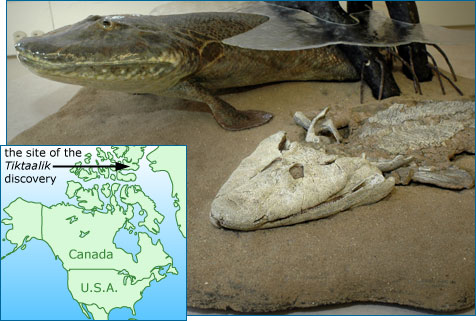Paleontologists led by Prof Neil Shubin from the University of Chicago have discovered unique fossils of Tiktaalik roseae – the most compelling example yet of a creature that was at the cusp of the fish-tetrapod transition.

This image shows a reconstruction of Tiktaalik roseae. Image credit: Tyler Keillor / Beth Rooney.
The fossilized pelves and a pelvic fin of Tiktaalik roseae reveal that the evolution of hind legs actually began as enhanced hind fins, according to the scientists. This challenges existing theory that large, mobile hind appendages were developed only after vertebrates transitioned to land.

“Previous theories, based on the best available data, propose that a shift occurred from ‘front-wheel drive’ locomotion in fish to more of a ‘four-wheel drive’ in tetrapods. But it looks like this shift actually began to happen in fish, not in limbed animals,” said Prof Shubin, who is the lead author of the paper published in the Proceedings of the National Academy of Sciences.
Discovered in 2004 by Prof Shubin, Dr Edward Daeschler of Drexel University, and the late Dr Farish A. Jenkins, Jr., of Harvard University, Tiktaalik roseae is the best-known transitional species between fish and land-dwelling tetrapods.

Tiktaalik roseae lived in Devonian period around 375 million years ago. It was a predator with sharp teeth, a crocodile-like head and a flattened body. The animal looked like a cross between a fish and a crocodile, growing up to a length of 9 feet as it hunted in shallow freshwater environments.
Tiktaalik roseae had gills, scales and fins, but also a mobile neck, robust ribcage and primitive lungs. In particular, its large forefins had shoulders, elbows and partial wrists, which allowed it to support itself on ground.

Only specimens containing the front portion of the animal, however, have been described thus far.
As the researchers investigated additional blocks recovered from their expeditions to the dig site in northern Canada, they discovered the rear portion of Tiktaalik roseae.

This image shows the fossil fragments of Tiktaalik roseae. The box shows a block containing the pelvic fin. Image credit: Shubin NH et al.
The fossils included the complete pelvis of the original ‘type’ specimen, making it possibly to directly compare the front and rear appendages of the animal.
The scientists were immediately struck by the pelvis, which was comparable to those of some early tetrapods. It was still clearly fish-like, but the expanded size, mobility and robusticity of the pelvic girdle, hip joint and fin of Tiktaalik roseae made a wide range of motor behaviors possible.
“It’s reasonable to suppose with those big fin rays that Tiktaalik roseae used its hind fins to swim like a paddle. But it’s possible it could walk with them as well. African lungfish living today have similarly large pelves, and we showed in 2011 that they walk underwater on the bottom,” Prof Shubin said.
“Regardless of the gait Tiktaalik roseae used, it’s clear that the emphasis on hind appendages and pelvic-propelled locomotion is a trend that began in fish, and was later exaggerated during the origin of tetrapods.”
Source: sci.news








